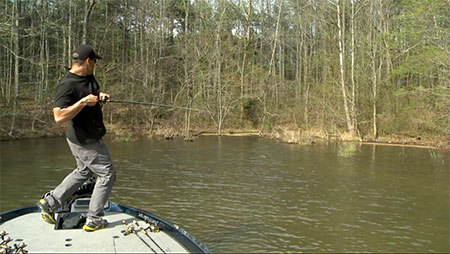A well-dressed swim jig is an extremely versatile tool in bass fishing. It’s very effective when bass are in a “little bit of everything” mood. It seems like the late summer and early fall is custom tailored for just that style of fishing. Some bass are deep and difficult to catch this time of year, others take up residence around various shallow cover, some begin to migrate into creeks to follow and intercept shad, and some are totally weather dependent in their feeding moods. Covering water is a good strategy, and that’s where the swim jig comes into play.
The thing about a swim jig this time of the year that’s so deadly, as opposed to other moving baits, is the fact that it’s relatively silent. By late summer/early fall, chances are your favorite bass lake has seen a lot of fishing pressure. Standard moving baits like vibrating jigs, spinnerbaits and shallow crankbaits are often turned down by bass because they may be a little too intrusive or loud for a reluctant and gun-shy bass. The swim jig still has the element of surprise and the bulky profile to make big bass react, but it simply performs in a more subtle and silent way.
I like to use a fast moving white swim jig for the majority of the situations I’m faced with. Other colors work well, but I like white mostly because I could see it, and when the bass eats it, I could watch it entirely disappear before setting the hook. I use a 1/4 oz white skirted Dave’s Tournament Tackle swim jig with a Culprit DW3 trailer, and even shorten the DW3 body and the skirt slightly at times to give it a more compact profile if the situation calls for it. I always use 50 lb Sunline FX2 braid on a Pinnacle 7’6″ med/hvy rod and a high speed reel regardless of the water clarity. With braid, I feel the sensitivity and close contact of the bait’s feel is necessary, but even more importantly I just want to get the committing fish away from the heavy cover as quickly as possible and to the boat. Another big reason I use braid is because I feel the quick speed of the swimming jig supersedes the necessity of the stealthiness of the line. Many anglers feel braid’s visibility to a fish could deter strikes, but I feel it’s simply not an issue with a quick moving swim jig scooting by the choice cover. They just react and eat it. And when covering water effectively, that’s what you’re doing, a couple key casts and your out of there and on to the next area.
The Culprit DW3 trailer’s design makes it run true and flat at all retrieve speeds, making it a great choice to match up with your favorite swim jig and just start firing around at targets that you think bass would be holding on. Because it looks so realistic, many times bass will even come out of nowhere and crush it in shallow open water. The trailer plastic is very durable yet pliable so that it has the perfect action, while remaining intact and running true even in the case of a fish short striking the bait or the tails only. Therefore, you’re ready to throw right back at the spot, or just keep moving along if you feel that fish was too small. That’s a really important set of features when fishing a swim jig because it’s essential to be as efficient as possible. Time wasted rigging or tuning the bait to run true, could mean less fish in the boat.
So if you’re going out to your favorite lake in the late summer or early fall and you show up not knowing what to expect from the bass, you’re not alone. Chances are, they don’t even know what their going to be doing that day. Their all about opportunities too. Try moving frequently and rotating locations with key cover, keep your rod tip popping at about 10 o’clock, and bulge the surface while swimming a jig around whatever looks right. I would bet your going to be pleased with the results.

